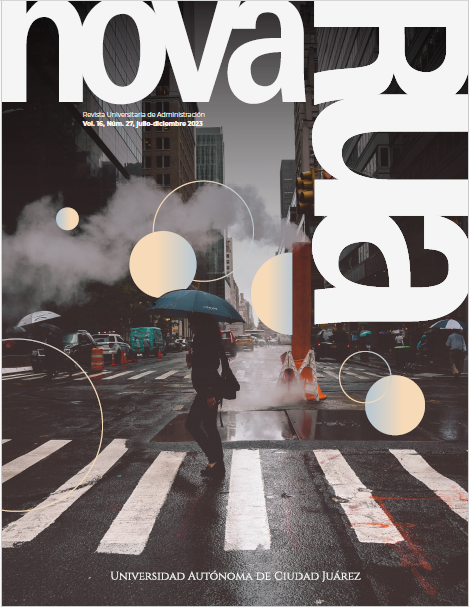Tendencias en la orientación de la publicidad: Reorientación y la precepción del usuario sobre las plataformas de comercio electrónico en ciudades de Colombia e Israel
DOI:
https://doi.org/10.20983/novarua.2023.27.2Palabras clave:
Publicidad, Comercio electrónico, Mercadotecnia digital, Medios de publicidadResumen
La publicidad en los medios digitales ha experimentado cambios por la bienvenida de la industria 5.0, transformando las formas promocionales en el consumidor digital y sus conductas sobre los productos ofrecidos, logrando una influencia en la precepción sobre la decisión final de usuario. Se pretende analizar las tendencias de la segmentación o “targeting” de la publicidad en las plataformas de comercio electrónico y su incidencia en la percepción del usuario digital. La metodología es de tipo descriptiva, dentro del paradigma postpositivista, con un muestreo probabilístico de la población consumidora digital, encuestados en las ciudades de Barranquilla, Colombia y Tel Aviv, Israel. Los resultados señalan que la presencia de la retargizacion es 4.38 general, estando muy presente en los consumidores, la segmentación psicográfica es de 2.55, con baja presencia, la segmentación geográfica de 4.15 “presente” y segmentación conductual con 3.77. Las nuevas tendencias han impactado el mercado con estrategias de marketing.
Citas
Armstrong, G., Adam, S., Denize, S., y Kotler, P. (2014). Principles of marketing. Pearson Australia Group.
Borg, K., Lindsay, J., y Curtis, J. (2021). Targeted change: Using behavioral segmentation to identify and understand plastic consumers and how they respond to media communications. Environmental Communication, 15(8), 1109-1126. DOI: https://doi.org/10.1080/17524032.2021.1956558.
Brotspies, H., y Weinstein, A. (2019). Rethinking business segmentation: a conceptual model and strategic insights. Journal of strategic marketing, 27(2), 164-176. DOI: https://doi.org/10.1080/0965254X.2017.1384750.
Davidson, D. (1991). Three varieties of knowledge. Royal Institute of Philosophy Supplements, 30, 153-166. DOI: https://doi.org/10.1017/S1358246100007748.
Desimpelaere, L., Hudders, L., y Van de Sompel, D. (2022). Children’s hobbies as persuasive strategies: the role of literacy training in children’s responses to personalized ads. Journal of Advertising, 1-16. DOI: https://doi.org/10.1080/00913367.2022.2102554.
Ferreira-Barbosa, H., García-Fernández, J., y Cepeda-Carrión, G. (2023). The Mediating Role of e-Lifestyles to Use the Fitness Center App. International Journal of Human–Computer Interaction, 1-10. DOI: https://doi.org/10.1080/10447318.2023.2204273.
Griva, A., Zampou, E., Stavrou, V., Papakiriakopoulos, D., y Doukidis, G. (2023). A two-stage business analytics approach to perform behavioural and geographic customer segmentation using e-commerce delivery data. Journal of Decision Systems, 1-29. DOI: https://doi.org/10.1080/12460125.2022.2151071.
Hayes, J. L., Holiday, S., y Park, H. (2022). Corporate social responsibility & the advertising strategic planning process: a literature review & research agenda. International Journal of Advertising, 41(2), 210-232. DOI: https://doi.org/10.1080/02650487.2022.2038432.
Helmold, M. (2022). Market Segmentation, Targeting, Differentiation and Positioning. En Helmold, M. (Ed.), Performance Excellence in Marketing, Sales and Pricing: Leveraging Change, Lean and Innovation Management (pp. 105-116). Springer International Publishing.
Kim, J. (2021). Advertising in the metaverse: Research agenda. Journal of Interactive Advertising, 21(3), 141-144. DOI: https://doi.org/10.1080/15252019.2021.2001273.
Lang, V., y Lang, V. (2021). Digitalization and Digital Transformation. En Digital Fluency. Apress. DOI: https://doi.org/10.1007/978-1-4842-6774-5_1.
Lee, H., y Cho, C. H. (2020). Digital advertising: present and future prospects. International Journal of Advertising, 39(3), 332-341. DOI: https://doi.org/10.1080/02650487.2019.1642015.
Li, H. (2019). Special section introduction: Artificial intelligence and advertising. Journal of advertising, 48(4), 333-337. DOI: https://doi.org/10.1080/00913367.2019.1654947.
Liu, H., Huang, Y., Wang, Z., Liu, K., Hu, X., y Wang, W. (2019). Personality or value: A comparative study of psychographic segmentation based on an online review enhanced recommender system. Applied Sciences, 9(10), 1992. DOI: https://doi.org/10.3390/app9101992.
Mark, T., Dhar, T., Verhoef, P. C., y Lemon, K. N. (2023). How is retargeting related to purchase incidence, channel choice, and purchase quantity?. Marketing Letters, 1-14. DOI: https://doi.org/10.1007/s11002-023-09693-4.
Permanasari, K. I., Sarosa, M., Moentamaria, D., y Zuhri, F. M. A. (2022). The Influence of Marketing Mix and Demographic Segmentation on Customer Satisfaction. En Annual Management, Business and Economics Conference (1[1], 144-149). Recuperado de: http://proceeding-ambec.polinema.ac.id/index.php/ambec2022/article/view/37.
Preston, C. (2005). Advertising to children and social responsibility. Young Consumers, 6(4), 61-67. DOI: https://doi.org/10.1108/17473610510701322.
Rathore, B. (2023). Digital Transformation 4.0: Integration of Artificial Intelligence & Metaverse in Marketing. Eduzone: International Peer Reviewed/Refereed Multidisciplinary Journal, 12(1), 42-48. Recuperado de: https://www.eduzonejournal.com/index.php/eiprmj/article/view/248.
Sayoh, M. M. R. (2023), Utilizing Artificial Intelligence in Digital Out-of-Home Advertising. International Design Journal, 13 (4), 417-425. DOI: https://dx.doi.org/10.21608/idj.2023.305380.
Stidsen, B. (1975). Market segmentation, advertising and the concept of communication systems. Journal of the Academy of Marketing Science, 3, 69-84. DOI: https://doi.org/10.1007/BF02729959.
Subawa, N. S., Widhiasthini, N. W., Astawa, I. P., Dwiatmadja, C., y Permatasari, N. P. I. (2021). The practices of virtual reality marketing in the tourism sector, a case study of Bali, Indonesia. Current Issues in Tourism, 24(23), 3284-3295. DOI: https://doi.org/10.1080/13683500.2020.1870940.
Sung, E. C. (2021). The effects of augmented reality mobile app advertising: Viral marketing via shared social experience. Journal of Business Research, 122, 75-87. DOI: https://doi.org/10.1016/j.jbusres.2020.08.034.
Zatonatska, T., Dluhopolskyi, O., Artyukh, T., y Tymchenko, K. (2022). Forecasting the Behavior of Target Segments to Activate Advertising Tools: Case of Mobile Operator Vodafone Ukraine. Economics, 10(1), 87-104. DOI: https://doi.org/10.2478/eoik-2022-0005.
Zierau, N., Hildebrand, C., Bergner, A., Busquet, F., Schmitt, A., y Marco, J. (2023). Voice bots on the frontline: Voice-based interfaces enhance flow-like consumer experiences & boost service outcomes. Journal of the Academy of Marketing Science, 51, 823-842. DOI: https://doi.org/10.1007/s11747-022-00868-5.
Descargas
Publicado
Número
Sección
Licencia
Derechos de autor 2023 Mauricio Junior Santamaría Ruíz, Brays Pérez Barragán, Sebastian David Hinojoza-Montañez

Esta obra está bajo una licencia internacional Creative Commons Atribución-NoComercial-CompartirIgual 4.0.
Todos los contenidos de la edición electrónica de la revista se distribuyen bajo una licencia de uso y distribución “Creative Commons Reconocimiento-No Comercial-Compartir Igual 4.0 Internacional” (CC-BY-NC-SA). Puede consultar desde aquí la versión informativa de la licencia.
Aquellos autores/as que tengan publicaciones con esta revista, aceptan los términos siguientes: a) Los autores/as conservarán sus derechos de autor y garantizarán a la revista el derecho de primera publicación de su obra; b) Se permite y recomienda a los autores/as difundir su obra a través de Internet (p. ej.: en archivos telemáticos institucionales o en su página web), lo cual puede producir intercambios interesantes y aumentar las citas de la obra publicada. (Véase El efecto del acceso abierto).












